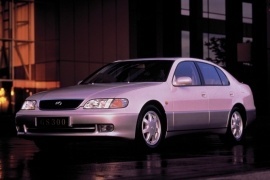Lexus was on the verge of conquering the U.S. market and introduced the GS range in 1993 based on the 1991 Toyota Aristo.
Toyota didn’t want to take any risks and ordered the design at Italdesign and introduced the Aristo on its home market to see if there were any design or engineering faults. After two years, it introduced the re-badged version of the car on the North-American market as Lexus GS. It was a hit.
Designed to compete against the much-famed BMW 5-Series and Mercedes-Benz E-Class, the GS sported a European styling with narrow, rectangular headlights and a raked front fascia. Its bumper sported a lower grille with one horizontal slat flanked by a pair of fog lights. The chromed trim around the main black grille on the hood gave the car a distinguished look. From its side, the cab-rearward design and the short trunk defined a sporty image.
Inside, the carmaker designed the instrument cluster and the center stack centered around the driver and then adorned the cabin with leather upholstery and wood veneers. But Toyota insisted on keeping the climate controls above the audio unit, even though most customers used the volume knob and the preset radio stations more often than the ventilation buttons. The main reason for that was reliability since the audio system was protected from heat and cold air as long as it was mounted lower on the center stack. The GS offered excellent interior room for the driver and more than adequate for the rear passengers.
Under the hood, Toyota installed a 3.0-liter V-6 engine, which was already proven on other vehicles. It paired it as standard to a four-speed automatic transmission, which sent the power to the rear wheels.

























































